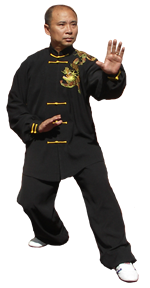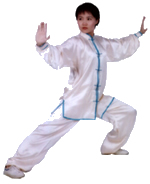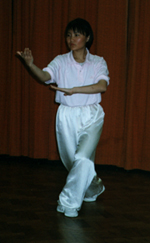![]() The History, Development and Practice of Sun Style
The History, Development and Practice of Sun Style
Sun Style Tai Chi was created by Great Grand Master Sun Lu Tang, one of China's most prominent Martial Arts Master in recent Chinese History. He was also a highly accomplished Xing Yi and Bagua Master. As the most senior student of Sun Lu Tang, my great grandfather Grand Master Li Yu Lin was one of the main disciples assisted and represented Sun in his teaching.
Deyin Taijiquan Institute is the biggest organisation in Europe with direct lineage from the Sun Creator Grand Master Sun Lu Tang, Professor Li's grandfather Li Yu lin was the most senior student of Sun Lu Tang. There are three main branches of the Sun Lineage in China and the world, Sun Lu Tang's Son & Daughter and His most senior student Li Yu Lin. The Deyin Taijiquan Institute is the Li Yu Lin branch of the Sun Style.
As a family tradition, it was passed down to my father Professor Li and subsequently myself and Tary. through the last 4 generations, we have taught and learned as closely as the way it was taught by Sun Lu Tang. All the detail, philosophy and inner essence of our learning and teaching remain true to the traditional value of Sun Style Tai Chi passed down by Sun Lu Tang and my Great Grand Father Li Yu Lin.
Sun Style greatly emphasises self-rejuvenation and meditation when practising movements. For example, Sun Lu-Tang wrote in his book: "...men were born with original qi, but (they grow up) without the external physical training or the internal mental discipline. The result is that yang and yin are disunited and external and internal is uncoordinated." From this comment, you can draw a clear message that the rejuvenation of qi is undoubtedly important.
As for the movements, Sun Style Taijiquan was derived from Hao Wei Zhen's Hao Style, which has smaller movements and frame, unlike Yang Cheng Fu's Yang Style - big and open postures. However, it has different features from Hao Style Taijiquan, too. Sun Style movements require constant transferring of balance by bringing the empty foot closer to the solid one, whereas Hao Style movements tend to have fewer changes in footwork and are using more of a bow stance.
Moreover, Sun Style movements encourage the use of waist movements and changes in hand movements, whereas Hao Style movements require one arm to protect half the body, with the hands always aligning with the outer line of the feet. If you study Sun Style Taiji movements closely, you will find many postures are less open, with both feet close to each other, with the hands closer to the body, too.
When its movements do have a wider stance, you will find the stances tend to have some similarities to Xingyiquan stances. For example, when we compare Sun Style Taijiquan movement, "San Tong Bei" (see top picture) and Xingyiquan movement "Pao Quan" (see bottom picture), you will find that the stance, distribution of body weight and the position of arms in both pictures is almost identical. The exception is that "Pao Quan" uses fists while "San Tong Bei" uses palms. Here, the stance is shown in Sun Style Taijiquan posture "San Tong Bei" is the same stance as "San Ti Shi" (see picture on the previous page), which is the most basic and essential stance in Xingyi practise. "San Ti Shi" stance can be described as a higher posture than bow stance, with a share of 40% to 60% of body weight carried between two legs. This stance appeared again in another Sun Style movement "Snake Creeps" (or "Push Down").
Sun Lu-Tang said in his book "The Study of Form-Mind Boxing" that: "all changes in movements come from San Ti Shi," which means that this stance is the root of internal energy flow. This is because the stance of San Ti Shi is an effective stance to encourage the qi to be accumulated and focused at its centre (the dantian) and subsequently to achieve better rejuvenation.
You may also notice that unlike other styles of Taiji, Sun Style movements often involve cross stance (see picture on the previous page) rather than both feet moving parallel to the front. This means that when you take a step forward, the position of the advancing foot is not pointing towards the front but with an angle to the side. This is a similar approach to Bagua Zhang (see picture) practise, where each step is directed at an angle, not in a straight line. In this way, the waist movements are utilised to encourage the coordination between legs and hands.

There are currently three Sun Style Taijiqan hand forms students can learn, namelyes Sun Style short form (38 posture), Sun Style competition form (73 posture) and Sun Style long form (97 posture). For advanced practise, pushing hands is an important part of Sun Style Taijiquan training, which was discussed in the second part of Sun Lu-Tang's book "The Study of Taiji Boxing."
Sun Style Long Form
This is the form of Taijiquan, introduced in Sun Lu-Tang's book "The Study of Taiji Boxing", in 1919. Unfortunately, there has been little known in the United Kingdom about Sun Style's content and form structure until 1994, when professor Li Deyin demonstrated the traditional form during an annual seminar. For the first time ever in Britain, Taijiquan enthusiasts had the opportunity to watch the entire routine performance. In fact, the seminar organiser recalled that many students were fascinated at what they saw.
Since then, Deyin Taijiquan Institute (GB) has put considerable effort into promoting the art to Taijiquan enthusiasts. The long-form routine consists of 97 movements. Movements throughout the form are gentle and graceful. There is no power exertion, no jumping movements and because the steps are nimble and constantly moving, it does not put the bodyweight onto one leg for too long. However, to learn this long-form without any previous training in internal martial arts is difficult. It is advisable for those who are making a fresh attempt to start the study with the Sun Style short form.
Sun Style Competition Form
This form was compiled in 1991, in response to the lack of uniformity in the content and structure of the traditional routine when it comes to competition. The competition form is, therefore, introduced with the intention to standardise its movements and raise standards of Taijiquan competition.

It must be said that there has been a great deal of investigation, research and consultation put into the process of compiling the form, as was the case in compiling many other competition forms. This routine has been favourably received by athletes, coaches and judges. It consists of 73 movements with most of the movements being based on the traditional long form. However, a few movements have been modified in the competition form so that athletes' flexibility, stamina and control of balance can be well tested. This routine is recommended for those who are interested in taking part in Taijiquan competitions.
Sun Style Short Form
Sun Style short form was compiled by Professor Li Deyin and Master Tary based on the traditional routine. It is designed and should be used as the prototype for those who are new to the style. It gives a good flavour of the original art yet it can be learned and performed in a short period of time.
This short form is a foundation and will pave the way for one to study further afield with Sun Style Taijiquan. It takes about 10-12 hours of instruction to learn the form. With this short form as a foundation, you can further your study of the traditional form or the competition form easily.
From Professor Li Deyin's 35 years of teaching experience, he feels people who are interested in advanced training in Sun Style Taijiquan will have little difficulty with the short form as a stepping stone.
Conclusions
Sun Style Taiji is a unique art created by a great master, whose knowledge and understanding of internal martial arts was once acknowledged as "the highest among people in the martial art circle and seldom seen among scholars." There has been a lack of knowledge and understanding of this style in the past and there are certainly not enough expert coaches outside China to provide in-depth training on the system. However, Sun Style Taijiquan is now being promoted worldwide. Its distinct characteristics have gained popularity in areas like Macao, Japan, Hong Kong, UK and the USA. Deyin Taijiquan Institute (GB) is one of the main organisations outside China promoting art with considerable background and expertise. Those who are interested in studying Sun Style Taiji should start with the short form and work their way through, step by step. We hope that everyone, through learning Sun Style Taiji, will achieve sound knowledge, discipline and good health.
Sun style Taijiquan is one of the five major schools of Taiji that are most widely practised around the world today. It is characterised by quick, nimble movements, good co-ordination between the opening and closing of the hands, rigorous method of performance and graceful bearing.
It was founded by legendary master Sun Lu-Tang in the early twentieth century. Grand Master Sun was a very bright, diligent and talented martial arts student and he was first inspired by the effective fighting theories and tactics of Xingyiquan (Hsing Yi Ch'uan). He studied with the great Xingyi master Guo Yun Shen for many years and consequently became very skilled in the discipline.
At the time, his teacher, Guo, had become friends with Bagua master Cheng Tin Hua and agreed that top students from each system should study with the other in order to refine their skills. Therefore, Sun began his study of Bagua Zhang.
His love for martial arts never ended; he began his Taijiquan (T'ai Chi Ch'uan) study when he had already gained martial arts fame. His modesty touched Hao Wei Zhen (who practised Hao style, also known as the Wu Style Taijiquan from Wu Yu Hsiang). Hao later became Sun's Taijiquan teacher.
After devoting over 40 years of research and study to Xingyi, Bagua and Taiji

by 1916, Sun had completed his famous books on both systems: "The Study of Form-Mind Boxing" and "The Study of Bagua Boxing". However, Sun's talent did not stop at only Xingyi and Bagua. He was to achieve the greatest of all, a Taijiquan system that absorbs and draws strength from all three disciplines and reflects the essence of martial arts. In 1919 he completed the manuscript for his third book "The Study of Taiji Boxing", which is now referred to as the origin of Sun Style Taijiquan today.
I studied Sun Style Taijiquan and Xingyiquan as the fourth generation under my family tradition since my great- grandfather, Li Yu Lin (1885-1965), was a top student of Sun Lu Tang. Through my practise and studies, I feel that a few findings are worth sharing with Taijiquan enthusiasts. It is my wish to carry on my family's tradition, not only by improving my own ability and understanding but also by benefiting others through teaching and writing.
Internal Aspects of Sun Style
Sun Lu Tang wrote in his book "The Study of Taiji Boxing" that: ". . . master (Hao Wei Zhen) has researched the (Taijiquan) art for many decades and has a deep understanding of the true method of it. I was taught by master (Hao) and have been practising the art day and night for many years. Now I have gained some understanding of the essential philosophy. Taking these findings further afield to compare my studies of Xingyiquan and Bagua Zhang, I found that the three belong to one family and this family divides into three different styles of forms. Although the three styles have different postures, they share the very same philosophy."
This idea of unity was the first attempt in documented history to establish a theory that three otherwise independent martial arts disciplines belong to one family, the family of internal martial arts. This is also the starting point of understanding Sun Style Taijiquan. The essential principles/philosophy mentioned by Sun can be concluded as follows:
1. The three martial arts are based on the philosophy of the I Ching and the Yin/Yang theory. On a personal level, when we were born, we were in a state of "yuan qi," or "original qi," which is the qi we inherit from our parents. When we start life, we are then in a state of "T'ai Chi" and everything is divided into Yin and Yang. As we grow older, we wear out our yuan qi, because we are not aware of the importance of rejuvenating our qi through physical exercise. In Sun style Taijiquan practise, as in Xingyiquan and Bagua Zhang, our aim and emphasis is to effectively cultivate, strengthen, refine and motivate the qi in our body. From this fundamental philosophy, it is not difficult to see the importance of the following principles when practising.
2. Mind directs the movement. In order to refine or purify the qi through the practise of physical forms, you must realise that the mind is playing a very important role. The key to it is to allow something to happen rather than to

make it happen. When practising Sun Style Taijiquan, one's movements are required to have three internal harmonies: unity between heart and mind, unity between mind and qi, and unity between qi and strength/power. Therefore, in your Sun Style Taijiquan practise, you should feel that each move contains within it a wave of momentum usually being pictured in the mind, starting in the feet, flowing through the body and being released through the hands. That is: root the feet firmly against the earth, feel the power of the movement come from your legs, and then direct the power with the waist and finally express the power with the hands.
3. Movements should be in harmony. No matter which internal martial art discipline, for it is common to all, that your movements should be natural and relaxed. In Sun Style Taijiquan practise, it is especially stressed that one's movements need to be well co-ordinated and smoothly connected like a flow of water. Crucial to the proper performance of the Taijiquan form is correct breathing. Correct breathing is abdominal breathing. Breathe naturally and deeply through the nose into the abdomen, neither holding your breath nor forcing the breath. Allow the pace of your breath to slow down. The mouth should be gently closed and your tongue should be lightly touching the upper palate inside the mouth.
When performing Sun Style Taijiquan movements, one of the distinctive features is the opening and closing hand postures. Many movements of Sun Style Taijiquan are connected by the open and close hand posture, particularly when turning the body to another direction.
It is essential to co-ordinate movements and breathing, to make sure that you inhale each time you do an "open hands" posture. You exhale when you do a "close hands" posture (see picture). This helps to maximise the blood circulation to all internal organs, especially to the liver and spleen.
Another characteristic of the Sun Style is the stepping method: advancing or retreating steps are usually followed by a half step forwards or backwards. This is different from other styles of Taijiquan, such as Yang Style where bow stance is widely employed for postures. When you practise Sun Style movements, you will find the bodyweight is constantly shifted between the two legs. Sun Style Taijiquan emphasises the good control of the balance between the transference of bodyweight so that all movements can be performed smoothly without a jerk, pause or sudden increase in speed. This is why Sun Style Taijiquan is also referred to as "open and close" Taiji, or "nimble step" Taiji.
It is important to understand that only when the mind, body and qi are in accord can you gain the power to generate and enhance the true qi and to heal. I feel lucky for the fact that when I started to learn Taijiquan as a teenager, I had the high-quality coach that others could only dream of. He was my father, Li Deyin (now officially honoured as one of the greatest living martial artists of China), a direct lineage student of Sun Lu-Tang. He has also trained thousands of students worldwide. Many of them have become well known international Taijiquan champions. He always encourages me to develop a deeper understanding of the principles of internal martial arts. He often said: "If you practise with only hands and feet without the mind, you will gain nothing at the end."
It is not easy, of course, to discover and fully understand the true meaning of art. It can be achieved only through practise, study, research and more practise.
The Dynamic Aspect of Sun Style Taijiquan
Sun Style Taijiquan is an internal martial art discipline that combines characteristics from Xingyiquan, Bagua Zhang and Taijiquan. As a style of Taijiquan, Sun Style stresses the importance of the internal aspect: using the mind to lead qi and qi to lead the body movements. They are used together with correct breathing technique and relaxed concentration.
